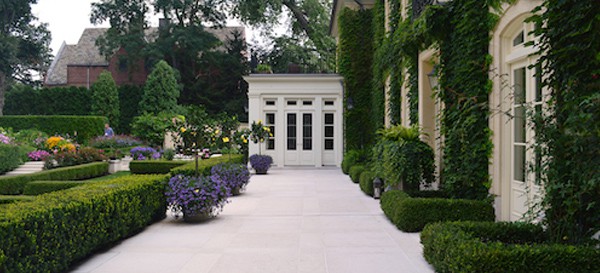For a space to feel complete, it must be clearly demarcated. A garden room may have walls, a floor, a ceiling or a window similar to rooms inside the home. Garden areas also have doors or entryways – some subtle and others more distinct. Intermixing plant material with hardscape elements to define space gives the garden a dynamic, living quality.
Baby Gem™ Boxwood is an ideal shrub for space-making with its rounded form, evergreen color and small stature. Low-growing shrubs can delineate and separate spaces without inhibiting views into or out of the garden room. Rounded forms are pleasing to the eye and allow for easy visual movement throughout a space. With a tidy three-foot stature, Baby Gem™ Boxwood is quite versatile in defining landscape rooms.
Implied Walls
Walls are used to separate one landscape room from another. Most garden rooms are not completely enclosed, but rather have a mixture of partial and complete walls. The height and mass of walls depends upon the extent of separation and enclosure desired. Baby Gem™ is ideal in creating a low-growing, partial wall. Low walls provide a suggestion of enclosure, but allow views outward into adjacent rooms. Such partial enclosures give a sense of seclusion without total isolation.
The evergreen hedges create a low-growing wall around the patio, providing clear spatial definition while allowing views into the adjacent garden.
Inviting Entryways
A variety of landscape elements are used to indicate the transition from one garden room to another. An entryway may be obvious, such as a gate. But more often can be subtle – the widening or narrowing of a path, a change in canopy elevation, or a well-placed boulder. Baby Gem™ Boxwood may be used in a variety of ways to mark spatial transitions. Potted in tall urns, a pair of boxwood flanking a pathway as it spills into an open lawn provides a classic transition. An informal design may feature a single boxwood planted in the ground or raised in a container at the confluence of two interconnecting spaces. Marking the entry to a garden room provides subconscious cues that help the mind interpret landscape structure.
Seamless Transitions
Connecting the more natural and informal areas of a landscape with formal spaces is often challenging. Boxwood and other structural shrubs may be planted as a thread of interconnectivity, weaving the formal out into the informal to soften the transition.
Potted boxwood lining the edge of a cottage-style planting carry an element of formality from the house outward into the landscape.
Walkway Magic
Emphasize the curves in a walkway by planting the rounded Baby Gem™ on the inside of the turn to accentuate the arc. Repeat the boxwood in several locations along the path to create a sense of continuity. For linear walkways there is nothing as timeless as a boxwood hedge. The solid rows of greenery guide movement throughout the landscape without impairing visibility.
Accentuate a Focal Point
Planted as a foundation, low shrubs and groundcovers emphasize sculptural elements and other focal points. Proportion is important – the planting must not overwhelm the focal point, but rather serve as contrast. Boxwood work best in this application in a formal setting.
While boxwood is a traditional choice for creating spatial structure and order in the garden, many other plants can be substituted to suit individual garden styles. Try these other structural plants from the Southern Living® Plant Collection: Chef’s Choice® Rosemary, ‘Sunshine’ Ligustrum or Mojo® Pittosporum.












